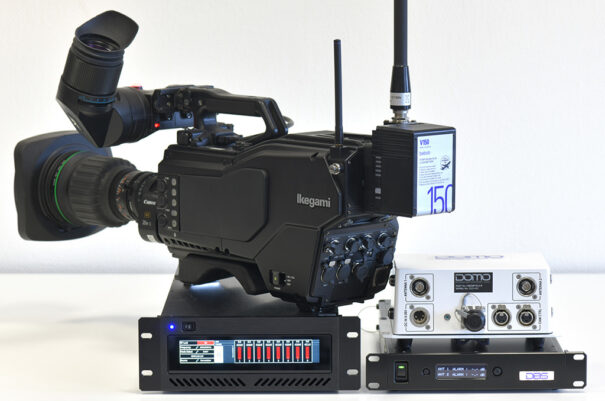Ikegami introduces new UHK-X700RF, SDI broadcast camera with native UHD sensor
The Ikegami Unicam-XE product family continues to grow with the new UHK-X700RF camera, a solution that evolves the UHK-X700 model with UHD capabilities and SDI technology that has been designed for news, live sports and events.
The UHK-X700RF is equipped with a native UHD sensor (3840 x 2160 pixels) with a global shutter architecture that supports UHD (2160@50p/59.94p) and HD (1080@50p/i, 59.94p/i) frame rates as standard. Like the other cameras in the Unicam-XE family, the UHK-X700RF incorporates a dual filter wheel that allows separate control of incoming light and color temperature. The system also supports effect filters or optical low-pass filters to reduce aliasing and moiré artifacts, and supports automatic optical vignetting correction when using OVC-compatible B4 bayonet-mount zoom lenses.
The camera is notable for offering a transmitter operating in the 2 to 2.7 GHz band, accessible in 250 kHz tuning steps and with an output power of 100 mW. Two antennas mounted on the rear of the camera comprise one for the main video signal and a smaller one for telemetry data.
Encoding is fast: typically only 40 ms from input to output at UHD or HD resolution. The transmission range in a standard configuration is approximately 550 meters. If the receiving antennas are located far away from the base unit, several IP-Mesh data transceivers can be cascaded. In this way, up to 22 transceivers can be used in a single system.
The main video signal receiver/decoder occupies a 19-inch half rack width chassis. It uses DVB-T modulation in QPSK, 16QAM and 64QAM. The bandwidth is switchable between 8 MHz, 7 MHz, 6 MHz and 5 MHz. To ensure robust signal quality even under critical circumstances, the DVB-T guard interval can be switched in four discrete steps: 1/32, 1/16, 1/8, 1/4. Forward error correction can also be flexibly selected between 1/2, 3/4, 5/6, 7/8 and 2/3 as default.
H.265-HEVC, H.264-AVC and MPEG-2 video encoding can be selected via the control menu. Almost all conventional broadcast picture frequencies for HD and UHD are compatible with ITU-R BT.709 SDR and ITU-R BT.2100 HDR, as well as with the wide color gamut BT.2020. The receiver/decoder is equipped with four SDI outputs and supports 1.5G, 3G and 12G SDI formats, including embedded audio. It also features two three-pin XLR analog audio outputs, a BNC Genlock input and a four-pin XLR 12-volt DC power input.
In its basic configuration, the receiver/decoder can be connected directly to up to eight downconverters (four antenna pairs) via conventional BNC cables. A cable extension of up to 100 m is supported. The distance between the receiver antennas and the Sapphire-RXD4 can be increased by using a fiber base unit in combination with a fiber extension unit. This can be achieved using a conventional SMPTE hybrid fiber/copper cable with LEMO connectors, allowing an extension of about 1,000 meters. The base unit also supplies power to the extension unit via the same cable.
¿Te gustó este artículo?
Suscríbete a nuestro NEWSLETTER y no te perderás nada.



